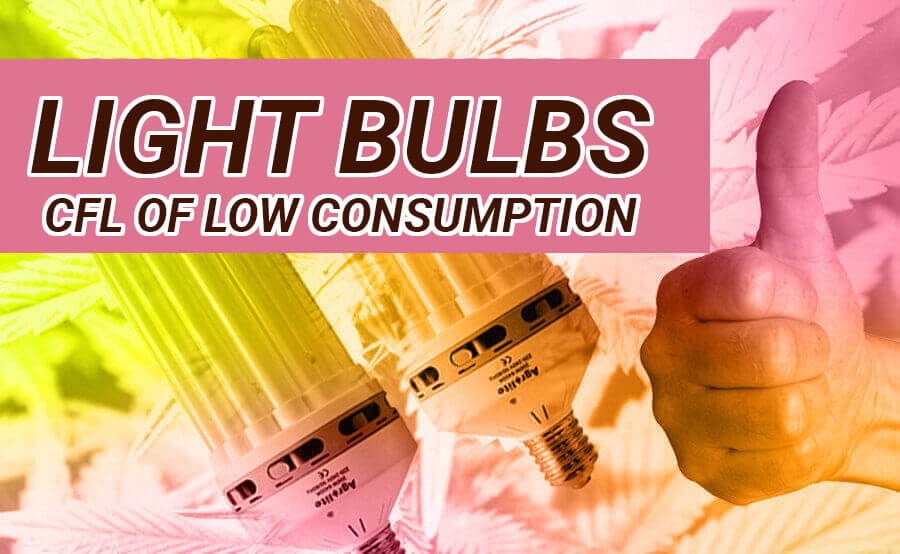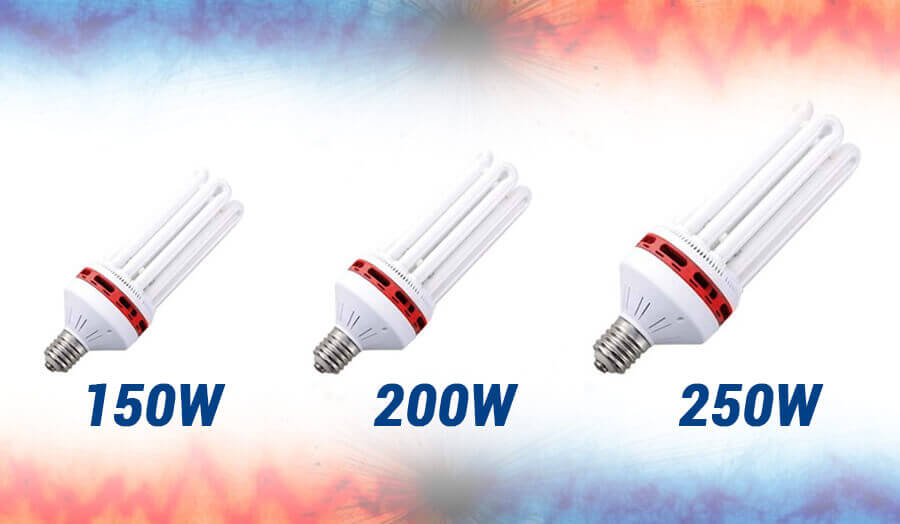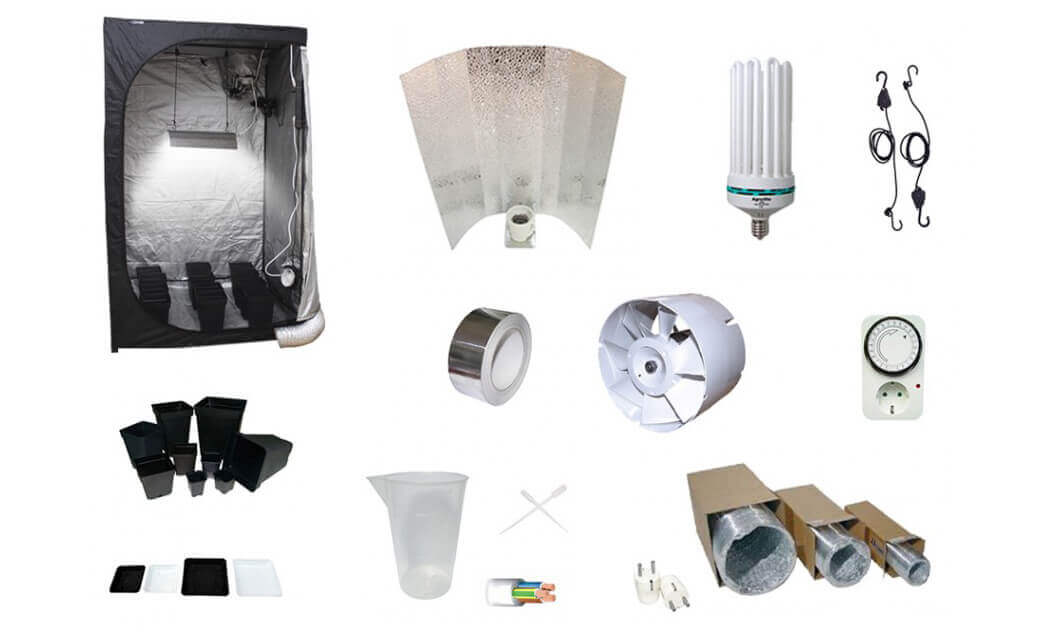The price of the kWh and the taxes that are paid (at least here in Spain) make people decide not to assemble their growing cupboard. If you smoke lightly, you don’t get those hours of dedication, fertilizers, preventive, watering… and a very expensive electricity bill. But let’s be frank, it’s not the same what you can buy out there as the joy of smoking your own weed. It’s something you’ve grown, you know what fertilizers you’ve used and even the love you’ve given him. Your marijuana always tastes better!

First, it should be noted that incandescent bulbs for life are NOT VALID for indoor self-cultivation, so we have to choose between the usual HPS, MH, LED or CFL. Within this diversity of luminaires, sodium lamps (HPS) are still the most widely used, but as alternatives when lowering our electricity bills, the use of LED technology or energy-saving light bulbs, which we are going to talk about in this post, the CFLs, is gaining ground.
LOW CONSUMPTION BULBS (LFCs) – Compact Fluorescent Bulbs
This type of lamps are the ones that we have had in our homes for years, the common low consumption lamps that we find in any store that sells electricity/lighting products. However, for our crop will not be enough 30,40 or 50W that we usually have at home. In order to equip our indoor we will need light bulbs of at least 125W (105W is the lower limit), although those of 250W will logically go better for our growth, we notice the power, but both its price and the electrical consumption will be greater. It should also be noted that this type of luminaire does not require a ballast as the transformer is integrated in it.
CFL bulbs do not emit the same heat than HPS bulbs, so we will not have temperature problems in the cabinet (especially if it is small). We can (and should) put them much closer to our plants without the risk of burning and without too much evaporation (we will water less, control it if you do not go over and rot roots). It is advisable to use a luxmeter to fix the height well. We say that they should be put closer because unlike other types of bulbs, their potential area of action is 30-40cm, not advising to put the lamps at a higher height.

In this way, together with your reflector, we must be careful structuring the cabinet so that the light reaches everywhere. The advantage of being closer to the plant is that plants will not stretch so much and will be more leafy or dense, more compact. That is something good for indoor cultivation of some varieties (especially sativa) and the lower temperature also translates into less smell inside the cabinet.
GROWTH PHASE
We don’t have to complicate ourselves too much during this cycle. If we have experience in indoor cultivation, it will be easy because, apart from controlling the height of the lights (to achieve maximum efficiency), the rest will be the same as with HPS lamps. We skipped the germination phase because we talked about it in other posts.
For the growth phase we will choose a CFL of white light, this is important because the light spectrum of white light will work much better in this phase because it stimulates growth more effectively (stem lengthening, branches and even roots). You already know that the light cycle recommended for this phase is 18h/6h (18 hours of light and 6 hours of darkness), although each master defines his own, there are people who prefer 20/4,19/5,17/7 or even 16/8. Time will also depend on the capacity of your interior and the variety cultivated, usually 3-6 weeks.
FLOWERING PHASE
For this stage we will choose warm light bulb (yellow) to encourage the maturation and fattening of buds. The cycle of light to go into flowering should be 12/12, trying to keep light out of the way during darkness.
The time of this phase will also depend on the selected variety, for example Critical++ or Early Skunk are fast varieties that will close the cycle up to 20 days earlier than many others. Let’s say that as a general trait, indica genetics take considerably less time than sativa, flowering ranges from 55-85 days.
REQUIRED MATERIAL
As we have mentioned before, if we already have experience in indoor we will not have problems about how to set up an indoor crop.
What we must be clear is that depending on the size of our wardrobe we will need one power or another. For example, for cabinets of 60x60cm or 80x80cm we could manage with a 150W lamp and for those of 1x1m or 1’20×1’20m we already have to go to 200W or 250W.
The basic material:
- Cultivation cabinet (possibility of several sizes)
- Reflector
- CFL lamp white light (possibility of several powers)
- CFL lamp warm light (possibility of several powers)
- Height adjustment pulleys
- Flowerpots (size and number will depend on cabinet size)
- Substrate
- Fertilizers
- Timer
- Luxometer

ADVANTAGES AND DISADVANTAGES:
Advantages
They emit almost no heat compared to HPS, making it much easier to manage the temperature in the self-cultivation cabinet. This is especially positive for small cabinets of 60x60cm where a sodium lamp raises the temperature a lot.
By lowering the degrees Celsius in our indoor the odor will also be lower than with HPS and furthermore the irrigation needs will also decrease as there is less evaporation.
You have several power possibilities (105 to 250W). There are even mixed light bulbs to do the whole cycle without the need to change from growth to flora (although it is advisable to use the specific ones for each moment).
If you adapt your cultivation method to this type of bulb, the quality of the production will not have anything to envy that obtained with another luminaire of greater power.
They’re inexpensive. Its price is not high, and they don’t need ballast so you save the price of the transformer.
Logically, the biggest advantage and so they are used is the savings in your electricity bill.
Disadvantages
The area of influence of this type of luminaire is less than that of HPS, the first 40 cm are used, so our crop should be directed to plants not very high that absorb all their potential. If we cultivate in the same way as with other lamps it will not work properly.
Although it is not mandatory it is advisable to change from white light growing to warm light in bloom, so we need 2 sets of bulbs. If we only have one of them, we could leave the whole cycle, but its effect will not be the same.
Now it’s up to you to decide. Are you convinced? Do you use it? Have you tried it? what do you advise?
We hope you enjoyed it and remember, SHARE IN YOUR SOCIAL NETWORKS



